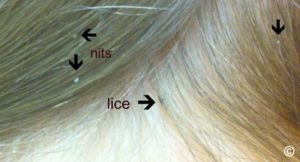Head lice are tiny six-legged insects that infest a person’s scalp and lay eggs, called nits. Since transmission of the bugs can happen just by close contact, infestation can spread quickly to others in public locations. Lice can live on furniture and carpet as well, making their infestation even more widespread in the home.

Are lice and nits the same thing?
Lice are six-legged insects. They crawl around and can be hard to spot because they can crawl quickly. Nits are eggs and are attached to the hair. They should feel smooth. Their color is off-white to brown and their size is slightly smaller than a sesame seed.
Do I have to get ALL the nits out?
Yes!! If nits are left on the head, they can live up to 2 weeks, hatch and start the cycle all over again. Check daily for 14 days to be sure that all nits are gone!
How do I identify lice?
They are approximately the size of a sesame seed. They have clear to brown bodies, depending on when they last ate. They cannot fly or jump, they only crawl. Nits are the lice eggs and they will be firmly attached to the hair strand.
How can I tell if my friends or I have head lice?
Intense itching on a person’s head and small, red bumps around the neck and shoulders can point to an infestation. Visual inspection reveals white specks the size of sesame seeds crawling quickly across a person’s scalp, while the nits are slightly smaller, smooth to the touch and an off-white color.
What should I do if me or a loved one has head lice?
Treatment with chemical or non-chemical shampoo kills the insects (if you use a chemical product, be sure to follow the directions carefully). Remove all nits from the hair. Treatment should be continued for seven days to ensure a complete cure.
Do all necessary housework/cleaning to rid your home of lice (see a nurse at the Health Department for more detailed information). After treating the person, objects and surfaces must be treated as well. Vacuum carpets and furniture, wash bed sheets and clothing and soak hairbrushes in hot, soapy water. To prevent the spread of lice, use hairspray and pull long hair back. School children can also keep their coats in trash bags while at school to stop the spread.
What shampoos or cleaners do you recommend?
Available products can be divided into chemical or non-chemical treatments. You must be very careful to follow the directions on chemical treatments as they have the possibility of exposure to toxins. There are a number of non-chemical treatments as well. We recommend Lice R Gone, (remove as a link) as we’ve had the most success with this brand.
Get more information from these useful websites:
